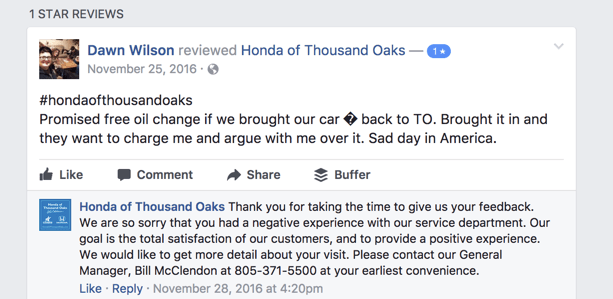
Managing an online reputation is a 21st-century business responsibility that simply cannot be ignored, or even placed on the backburner for any amount of time.
The online world of consumerism runs 24/7. It doesn’t take holidays, time off, or even a two-minute break. Regardless of what business ideas you might have, managing an online reputation comes with the turf. Even for small businesses with relatively low brand awareness, developing a bulletproof system is crucial for every growth-minded organization.
Now, as a small-to-medium sized business (SMB), you are probably dedicating a good deal of your budget to sales, marketing, production, etc. In other words, you are spending money to simply get to a point where you have an online reputation. The prospect of managing it is probably some ways down your list.
The good news is you don’t need a giant budget to manage an online reputation. If you play your cards right, you can stay on top of this crucial task with pocket change. Here’s how.
Take advantage of cost-effective or free monitoring tools
In the early stages of managing an online reputation, it’s relatively easy to stay on top of things like brand mentions, reviews, social media interactions, etc. However, as business picks up and you begin to build a decent online presence, it’s going to get harder and harder to keep tabs.
As a general rule of online reputation management, it’s always best to have tools and processes in place before you actually need them. Obviously, you don’t need anything fancy (at least not yet). Start by setting up Google Alerts to get a notification every time your brand name is mentioned.
Another good (and free) tool to use is IFTTT.com. This helps you connect all of your apps and devices so any online activity related to your business is quickly brought to your attention, no matter where you are.
In terms of social media listening, the free Hootsuite plan is a fantastic place to start keeping tabs on your presence across major networks. In addition to monitoring your mentions, this tool helps you schedule content delivery and manage your online sentiment.
All three of these tools are fantastic in laying the groundwork for online reputation management. The sooner you get your processes established, the better off you will be as your business begins to scale.
Create an outreach system to gain high-value user content
Customer reviews are an integral part of online reputation management. Moreover, they are perhaps the most influential pieces of content when it comes to purchasing decisions. To give you an idea, a study from Invespcro found that nearly 90% of consumers trust online reviews from strangers as much as a personal recommendation.

Source: Invesp
With this in mind, one of the biggest components to building an online reputation is simply getting people to leave sentiment about your business. This is an interesting task. While it might not seem like it on the surface, the very concept of online reviews has evolved quite a bit over the years.
To give a brief history, online reviews first emerged around 1999 and early 2000s during the Clinton impeachment. They were then used for patients to review doctors. As time went on, online reviews became a popular form of user-generated content for all businesses and products.
Realizing just how powerful they were in swaying purchasing decisions, many businesses would try shady tactics like forging fake reviews or paying others to write them. As many of the big review platforms started to crack down on these practices, consumers also started to wise up. Nowadays, most online customers have a strong radar for made-up reviews and are not swayed by a simple star rating and a vague sentence – regardless of whether they are real or not.
So where does this leave you?
As you develop a strategy for gathering online sentiment, you need an outreach process that encourages top-to-bottom feedback. This involves getting the pros, cons, overview, advice to the company, etc.
Now, you are kind of between a rock and a hard place here. On one hand, you want to get super in-depth, detailed reviews. On the other, you don’t want to make the forms too complex that people don’t want to fill them out.
In terms of the review form itself, the key is to create simplistic questions that ideally spur open-ended answers like the ones given below.
- What were the pros?
- What were the cons?
- What advice would you give to us?
- What advice would you give to other consumers?
These are just a few to keep in mind.
When it comes to developing an outreach system, there are several key guidelines to live by
1. Don’t jump the gun
Most of the time, you don’t want to follow up with a review request immediately after the purchase. Give it a day or two before you reach out.
2. Make it easy
Always remember, customers, are doing you a big favor by leaving their feedback. You don’t want to make them jump through a bunch of hoops. Be sure the forms you build are easily-integrated with email, mobile, or whatever apps you use.
3. Make the best use of social media
Social media can be a gold mine for feedback and engagement. Try asking general questions and using hashtags to get responses out of your followers.

Source: Twitter
4. Make them visible
The purpose of reviews is to present an unfiltered, third-party opinion of your business. In addition to social media and the major review platforms, make it a point to showcase reviews on your website, both the good and the bad.

Source: Bizzabo.com
At the end of the day, your outreach strategy is the guiding force behind developing your online presence. Take your time here and find the formula that works best.
Develop a plan for negative feedback
Getting negative online feedback is simply part of life in today’s business world, there is no getting around it. Dealing with negative feedback is a lot like washing dishes; no one particularly likes it, but you have to clean up the mess before it accumulates and gets out of hand.
Now, dealing with negative feedback isn’t always apples-to-apples.
For starters, as you look into customer review platforms, you need to take extra precaution to understand how it filters out fake or biased reviews. Fortunately, review technology has come a long way. Many of the bigger platforms have methods of pinpointing when companies try to sidestep the process. The last thing you want is for a competitor to sabotage you.
In the case you get some genuinely poor feedback, you need to have a plan to approach it. First and foremost, do not respond right away. Give it some time to marinate. You never want to respond immediately while emotions are high. Wait at least 12 hours to respond, and no longer than two to three days.
When it comes to responding, there are a few key points to remember
- Thank them for taking the time to leave a review.
- Accept responsibility.
- Respond rationally while staying true to your brand voice.
- Be concise in your response.
- Don’t throw yourself under the bus too far.
- Try to take the conversation offline.
Here is an excellent example of how to respond to a bad review

Source: Broadly
A bad review, while it may seem harsh at first, can actually be a good thing. Ultimately, the way you handle negative reviews says a lot more about your company than the review itself. Additionally, Google recently confirmed that responding to reviews impacts local SEO.
If you approach the situation carefully, you can turn a negative into a long-standing positive.
Know when it’s time to hire someone
As a small business grows, the task of managing an online reputation will obviously become more tedious. If you are carrying out these duties as an owner, you need to know where to draw the line and decide when it’s time to hire someone.
Developing a small business requires much, much more than keeping up with an online reputation. If you are finding that your time commitment here is overshadowing other important jobs, it’s probably time to step back and hand over the job to someone else.
Generally speaking, if you are spending more than one or two hours per day covering the duties involved with managing an online reputation, consider bringing someone on – at least part-time.
As you are likely on a small budget, it can be tough to justify this overhead. However, keep in mind that growing an online reputation never truly ends. Having someone solely dedicated to this task is an investment that will save you time, money, and headaches in the future.
Over to you
Online reputation management is a job you need to take very seriously, no matter how big or small your business is.
SMBs currently exist at an interesting point in time. They are growing their business when online sentiment plays a critical role in sales. Developing a robust plan and protocol for managing an online reputation early on is an integral part of long term success. Fortunately, doing so with a little-to-no budget is easier than ever.
Manish Dudharejia is the President and Founder of E2M Solutions Inc.
Related reading
The importance of online reviews is undeniable. Let’s talk about a few big ones in making online reviews one of the strongest weapons in your SEO arsenal.
This is something I’ve been mulling over for a while. I threw the question out to SEO Twitter, and was surprised and impressed by the volume of responses.
SEO expert Craig Campbell shares his experience on digital and flipping websites, pro tips, mistakes to avoid, conferences, and a lot more!
This marketing news is not the copyright of Scott.Services – please click here to see the original source of this article. Author: Manish Dudharejia
For more SEO, PPC, internet marketing news please check out https://news.scott.services
Why not check out our SEO, PPC marketing services at https://www.scott.services
We’re also on:
https://www.facebook.com/scottdotservices/
https://twitter.com/scottdsmith
https://plus.google.com/112865305341039147737
The post How SMBs can effectively manage their online reputation on a shoestring budget appeared first on Scott.Services Online Marketing News.
source https://news.scott.services/how-smbs-can-effectively-manage-their-online-reputation-on-a-shoestring-budget/




No comments:
Post a Comment